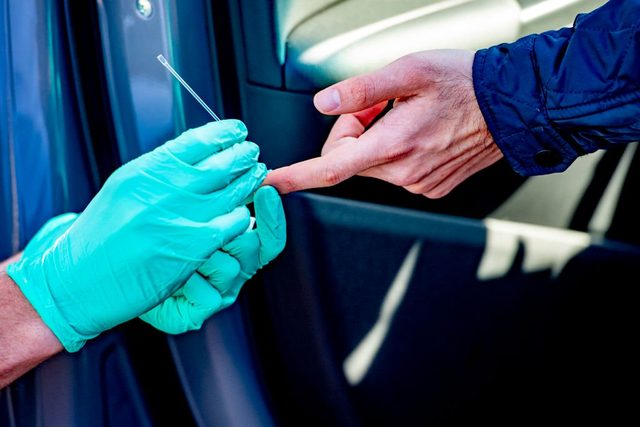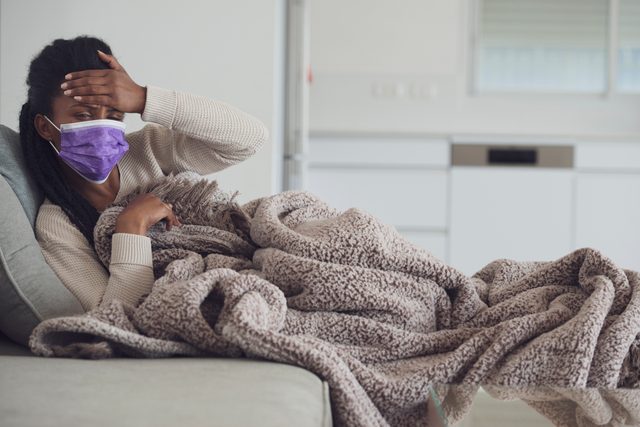If You Already Had Coronavirus, Could You Catch It Again?
In light of recent cases of apparent reinfection among recovered patients, it's natural to wonder if COVID-19 immunity is even possible. Medical experts weigh in.
Coronavirus cases continue to grow—at last count, more than 2.6 million cases around the globe, with more than 180,000 deaths, according to data from Johns Hopkins University. There’s also another noteworthy (though smaller) subset of people: Those who have had COVID-19 and recovered.
The availability of a COVID-19 vaccine for the general public still seems far away. One hope is that the population could at some point develop herd immunity. The concept is that if enough people become infected with the virus, and recover, the population might be more resistant to it because there are fewer people to spread the virus. This could act as indirect protection for individuals who are not immune to the disease (or who can’t get the vaccine, when and if one becomes available).
But, with COVID-19, this is more complicated. The World Health Organization (WHO) confirms they are investigating COVID-19 patients who seemed to retest as positive in South Korea. This raises a critical question. Did these people catch the virus again, or were they unable to fully fight off the first infection? All the U.S. Centers for Disease Control and Prevention (CDC) will say at this point is that the answer isn’t clear.
We spoke with several health experts to understand the relationship between COVID-19, reinfection, and immunity.
Coronavirus and immunity
“My expectation—in line with Dr. Anthony Fauci, who is a good person to be aligned with scientifically—is that immunity to coronavirus would function as it would for any other organism,” says Philip Bretsky, MD, a board-certified internist and primary care doctor, with a background in epidemiology, at Santa Monica Primary Care.
Dr. Bretsky explains that among China’s more than 81,000 reported cases of COVID-19, roughly 100 patients later tested positive for the virus a second time: That’s about 0.1 per cent of the total cases. In South Korea, 0.9 per cent of the country’s total cases may have been re-infected, or at least tested positive again after appearing to recover. At least at this moment—based on those numbers—a COVID-19 infection theoretically may lead to immunity 99 per cent of the time.
“There exists a number of other potential explanations for these repeat infections, but I would think that reinfection events, while possible, would be the exception rather than the rule,” says Dr. Bretsky.
Given the limited data, other experts are even more hesitant to make predictions. Georgine Nanos, MD, a board-certified family physician specializing in epidemiology and chief executive officer of the Kind Health Group, a company offering aesthetic care in Encinitas, California, thinks it’s impossible to say what’s going on. “We really don’t have enough information yet to give an informed scientific opinion. I don’t want to speculate.”
Throughout North America, the testing shortage has led to a lack of data; that’s one of the reasons it’s difficult to gauge coronavirus immunity, according to Dr. Nanos. “We’ve been behind from the start and are falling further and further behind as more people get infected and the virus spreads.” Without widespread testing to look at antibody development and resistance, it’s grasping in the dark.
The two types of antibodies that blood tests detect can give doctors differing clues about the patient’s infection status, says Purvi Parikh, MD, an infectious disease, allergy, and immunology specialist and clinical assistant professor at NYU Langone Health in New York, and board member of advocacy group Physicians for Patient Protection. “IgM antibodies tell us if someone has had a new or recent infection whereas IgG antibodies tell us about a past infection. IgG is helpful in assessing immunity as well.”
Antibody tests are not meant to diagnose a condition alone, since the body may not have had time to create antibodies soon after an infection. A better test for a current infection is a nasal swab (rather than a blood test), which picks up the genetic material from the virus itself and is detected with a technique called PCR, or polymerase chain reaction. (But antibody tests are necessary because a PCR test won’t tell you if you’ve been infected in the past.)
However, the World Health Organization says that even if someone tests positive for coronavirus antibodies in their blood, it’s not clear that they have immunity. “There’s been an expectation, maybe, that herd immunity may have been achieved and that the majority of people in society may already have developed antibodies. I think the general evidence is pointing against that… so it may not solve the problem the governments are trying to solve,” the WHO’s Michael Ryan, MD, executive director for health emergencies, told CNN on April 18.
Faulty tests may be to blame for people who retest positive
Possible explanations for apparent reinfection in countries like China and South Korea may be due to false negatives, where the infection was low and undetectable during testing, or false positives, according to a report in the British Medical Journal. Both WHO and South Korea are currently investigating supposed cases of reinfection.
Emily Gurley, MPH, PhD, an epidemiologist at Johns Hopkins University notes that reinfection has been reported in the media, but not in scientific studies. “There have been some reports which suggested that reinfection might have occurred for some patients, but this would be very unlikely and there are simpler explanations for what happened,” Gurley says.
“It’s much more likely the reports are simply the result of tests working imperfectly—either someone was assumed to have COVID-19 without a lab test and then later had an illness that actually was lab-confirmed to be COVID-19, or that the patient tested negative and then later tested positive just because the test sometimes gives false results,” she explains. “We know that there are issues with the tests, so this is the best explanation for what has been reported.”
During a press conference in Geneva on April 13, the WHO’s Dr. Ryan, said that like MERS-CoV (the coronavirus that caused the MERS outbreak in 2012), someone who contracts COVID-19 and develops detectable antibodies should have immunity for a period of time. However, as Dr. Ryan points out, it’s unclear what that duration of time is.

Virus mutation does not appear to be a cause for concern
While it’s possible that a person could be infected with a different strain of a virus, health experts don’t think that’s the case with COVID-19. Yes, the virus is mutating, but it doesn’t seem to be a cause for concern. “All viruses mutate,” says Dr. Bretsky, explaining that RNA viruses like COVID-19 mutate more rapidly than DNA viruses. “They lack the ‘proofreading’ enzymes present in DNA viruses. However, to our great relief, COVID-19 mutates quite slowly—at about half the rate of seasonal flu. This has positive implications both for the development of a vaccine as well as for an expected lengthy response of immunity after recovery from infection.”
The slow mutation rate of COVID-19 bodes well, with the new sequences similar to the original virus, which means that once the immune system recognizes the virus and has made antibodies against it, those same antibodies should protect you if you encounter the virus—or similar strains of the virus—in the future.
In fact, there are probably already different strains of the virus. Two new sets of data, one in April 2020 uploaded to medRxic, and the other from the NYU Grossman School of Medicine, separately but similarly, suggests there may be separate strains of COVID-19. The studies concluded that coronavirus in New York came to the area in mid-February. This is weeks before the first case was confirmed, and it seems like it was brought mostly from Europe, instead of Asia.
These strains are closely related. “There are multiple ‘strains’ of coronavirus, but each of these is fundamentally very similar to one another,” says Dr. Bretsky. He notes that, while the COVID-19 genome has 30,000 base pairs of genetic material, “even the most divergent strains only differ by 10s of base pairs.”
Knowing the different strains might be helpful in figuring out where they originated (say Europe versus Asia). However, “it is unlikely that these differences would impact disease severity,” Dr. Bretsky says. “Instead, the differences in disease severity and mortality rate are more likely related to host characteristics such as age and underlying chronic conditions.” (These are the people at higher risk for COVID-19.)
Of course, because there is such limited data, it’s impossible to completely discount the notion that some strains might be worse than others. “We are learning about this virus as we treat it, but yes it is possible that some strains may be deadlier than others,” says Dr. Parikh.

Some viruses can ‘hide’ in the body and then reactivate
One possible explanation for what appears to be a reinfection is that the body never truly conquered the virus, even though levels were low enough for a negative test result. Some viruses can cause a latent infection, and can lie hidden or dormant in a person’s DNA. They cause no symptoms until they are reactivated. For example, herpes simplex 1 can cause repeat outbreaks of cold sores throughout a person’s lifetime, and the chickenpox virus can be reactivated later in life and cause shingles. (Here are the symptoms of shingles you might be ignoring.)
However, coronaviruses are not thought to have the ability to cause latent infections or remain dormant in a person’s DNA.
“I think it is accurate to say that there is not yet evidence for latent infection with COVID-19 although there are mounting concerns about such,” says Dr. Bretsky. “To be truly latent, an infection not only has to persist in the host cells but then later has to be able to reactive to full viral gene expression and reproduce.”
Very few types of viruses have this ability, including HIV and herpes viruses, he says.
During the WHO press conference, Dr. Ryan addressed the issue: “On the issue of reactivation and latent infection, there are many situations, particularly in viral infection where someone doesn’t clear the virus entirely from their system.”
Other factors could cause a resurgence of symptoms that are not considered a true latent infection. “It can happen in the case of immunocompromised people who are sick for other reasons, and then the virus can come back and attack the person again, and that’s sort of seen as reactivation. It’s usually that the virus was never property cleared,” Dr. Ryan explained.
The truth is that it’s too early to say if people infected with COVID-19 go on to develop persistent, protective immunity, and if so, how long that immunity lasts. Currently, health agencies and experts worldwide are working with just five months of limited data on COVID-19, so until there is more testing of patients to determine if a virus has been truly cleared from the body, it’s unclear why some people had a resurgence of symptoms after appearing to recover.
Next, find out how coronavirus is different from all pandemics through history.






